Unbelievably, some people have asked me what I’m talking about. What is IDST, they ask, before putting a slipper on their hands and saying “DID I DO RIGHT MNNNNGGGGG”.
So, Lesson Zero : IDST stands for If Destroyed, Still True. You add it to a written insult to ensure that the person you are insulting remains insulted long after they’ve scribbled over it and said “SHUP UP YOU’RE BULLYING ME”. What follows details the historical wranglings between the insultors and the insultees.
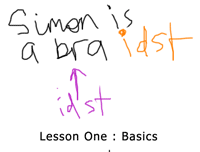 |
LESSON ONE : BASICS The purple IDST uses the trusty arrows technique to apply its protection. Both are equally effective. Simon, suddenly, has no logical way to prove that he is not a bra. Should he remain aloof, and ignore it – allowing the allegation to go unchecked? Or should he take active steps to "destroy" the graffito, which amounts to a signed confession? That is a matter for Simon. |
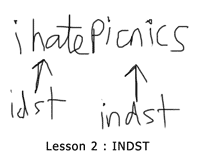 |
LESSON Well, no. To be honest, INDST has the stench of insecurity about it. The very fact that you hate picnics is written on a wall, desk or bus seat, should be conclusive evidence that it is true; to be overly concerned about what should happen should someone NOT destroy your graffiti, is to be close to neurosis. |
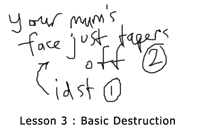 |
LESSON THREE : BASIC Of course, there’s nothing to stop you from writing your own reply – but negative graffiti, such as "my mum’s face doesn’t just taper off" occupies a strange area. In real life, people will believe you if you say "I’m gay" (unless you’re talking to an ugly woman). If you say "I’m not gay", however, they’ll say "alright, stop being so gay about it, you gay". The same applies to graffiti; negatively-phrased graffiti will be taken to mean the complete opposite of what it says. |
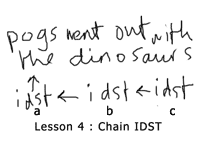 |
LESSON FOUR : THE CHAIN IDST Destroying (a) first activates (b), making (a), if anything, even truer than before. Now we have a similar situation as in Lesson Three – with IDST (a) now being the most true thing in the world, the main message will forever remain protected by it, and there’s nothing you can do about it, not now, not ever, not no way, uh-huh. Similarly – if you destroy (b), (c) promotes it to absolute truth, making (a) indestructable. The destruction of Chain IDSTs relies on the outermost IDST being unprotected by its own IDST; once you have an indestructible, non-conditional IDST in the chain you are destroying, you are lost. |
 |
Lesson 5 : The Gordian IDST |
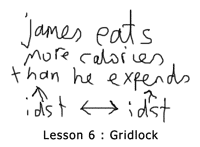 |
Lesson 6 : Gridlock Destroy one IDST, and the other automatically becomes the "straight dope". You’re therefore trapped – there is literally nothing you can do but pay awed homage to the innovators of the Gridlock method. If you are James, you might also face-hug a Tunnock’s Tea Cake. |
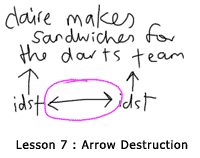 |
Lesson 7 : Arrow Destruction It became clear that the third, double-ended arrow was an entity in its own right, and could therefore be destroyed independently, allowing each IDST to be destroyed afterwards with ease. So no longer must Claire have to put up with the insinuation that she makes sandwiches for the darts team on their fortnightly visits to the local pub. |
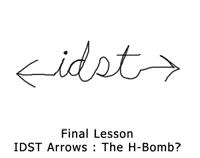 |
Lesson 8 : IDST Arrows : The IDST H-Bomb? To my knowledge, this has never been used in practice, and if you did employ an IDST arrow, people would probably say “fuck off, you gay”, which beats everything in these situations. |

Clear, concise and informative.
However, you have failed to incorporate any reference to the Welsh corrupting of the IDST phenomenon, that of ‘IDT INDT’ (If destroyed true, if not destroyed true’). Whilst it is tempting to dismiss this mutation as pure muttonry, mention of it would display a more complete understanding of your subject matter.
Please see me after class, with all pants removed.
Mr Nicholas, I would refer you to Lesson Two. INDST covers the area of negative IDST induction, and whereas it may not use the language of hill-fuckers such as yourself (If not destroyed true? Utter gash-rinse), it clearly deals with the matters to which you refer, darling.
Now get busy with the fizzy, this bra won’t unclasp itself.
There was also, of course, the “TINY” clause…
You could write
WARREN SLEEPS WITH HIS HEAD IN HIS MUM’S GASH
In nice big letters on a wall, or paper, or someone’s back. Then in small letters – big enough to easily see up close, but indistinct from a small distance, you’d write TID. Or “true if destroyed”. This forces Warren into a more poignant dilemma. As long as he leaves the graffitti up, there is no proof, no confirmation, nothing but a vague, silly suggestion of his pre-sleep requirements. But there is of course a big fucking piece of wall art insulting him and his mum.
But should he attempt to remove it, the ghastly truth emerges.
I like this one, because it offers hope, but in a very cruel way.
SL
Whilst reading the entry, I had an idea which could completely revolutionize the IDST industry, rendering all previous forms worthless, and all protests regarding the veracity of the written or ‘graffitied’ comments untenable.
Some may consider it overkill. However, considering these troubled times, and the development of new technology and theories in comment destruction and deniablility, i feel you can never be too sure.
Thus I hereby submit my patent for the new ‘Concentric-Atomic IDST Super Structure’, which provides a pretty much infinite trueness guarantee for whatever you happen to write, scribble or draw.
I am more than willing to provide the preliminary sketch-work for this – I would post it here, but I cant, so anyone who wants to see it will have to ask Log to post it somewhere, or get me to email it to them.
Here’s Spastemiser’s Atomic IDST Model. It’s truly breathtaking in its scope – by which I mean size – so here’s a link to it…
A link to it. lol
the problem with that, is we are still left with an outside level, and sucessive rubbings in the correct order can render the core message destroyable (sounds like a fantastic flash game in the making, to me).

i propose
this answer to the problem
With this development, the remover must invent a new weapon: break lines. This near-perfect situation is broken by adding small lines in between the inner idst and the outer one, so;
All of a sudden, the outer idst is removable, making it possible to destroy the message. This problem is unresolvable because if the inner idst was attached to the outer idst, it would be possible to destroy them all at once, leaving the message with no protection.
Thus there is always a way to remove any idst label, no matter how complex the nested labelling goes; there is no way to jump out of the system.
A way for the writer to circumvent this altogether is to include idst as part of the original statement, as per step one, and thus it automatically protects itself by referring to the whole sentence. Problem solved.
I’m afraid I don’t presently have the resources to present a visual example, but a thought has occurred to me on this matter. What if a sentence were to be constructed such that the words themselves took the shape of the pertinent letters?
Including idst as part of the sentence is all well and good, but it is still possible to remove that part, and thus its protection, before completely destroying the sentence itself.
Imagine, if you will, the phrase “Cameron puts bees in his porridge”. “Cameron” may be written vertically downwards, forming a capital I. “puts” is a little more difficult but, with practice, may be distorted to take the shape of a D. The S again is difficult but in this case I would suggest the three words “bees in his” are written along a properly planned curve to form the letter. The T is then trivial. “Porridge” may be written vertically in a similar fashion to “Cameron”, with the initial P simply widened to form the arms of the T, whilst the rest of the word becomes the shaft.
And there you have it. A construct that can be read both as the statement that we wish to get across, and as it’s own protection clause. Any attempt to destroy the protection will neccessarily destroy the message itself, rendering it true for all eternity.
I almost hesitate to release this idea into the public consciousness. If the terrorists get hold of this information, God help us all.
I am so in love with this idea that I want to have sex with it.
And you.
It has occurred to me that my idea is actually very similar to the so-called “H-bomb”. Whether the letters are integrated into the arrows or into the phrase itself is apparently irrelevant – the result is ultimately the same and clearly Cameron does indeed put bees in his porridge.
I would suggest that my solution is more elegant, in that it avoids the use of cluttersome arrows, but I admit it does demand a large amount of forward planning. A question of personal taste, perhaps.
For the love of God, get your hands out of your bum and write a new entry!
After a message has been written for example “Andrew is a bra IDST” if a second parentheses was added to the sentence, but the sentence itself not destroyed such as “andrew is a bra <- only after shagging your mum IDST" does this second addition hold true or is it in fact not true as its been added after the IDST?